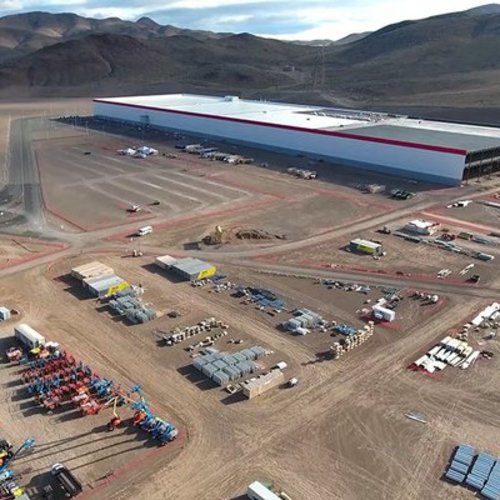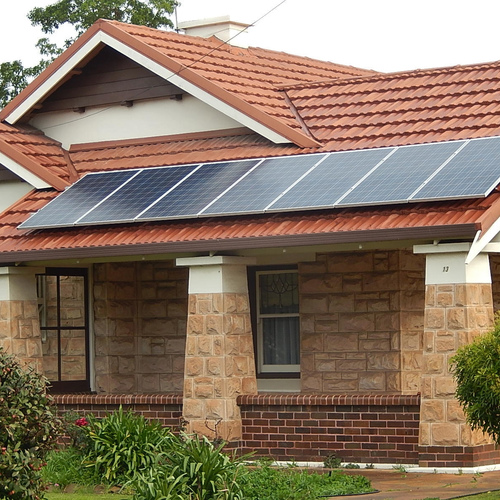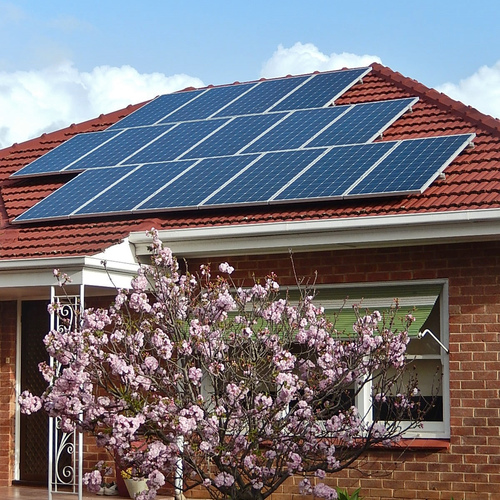
A few weeks ago, Brian Valle was at work in the mechanical room of a new house in Yarmouth, Maine, hooking up the last few parts of its solar energy system. Valle and a co-worker wrestled two gleaming Tesla Powerwall batteries, each of them weighting 276 pounds, up on their waiting wall brackets while another two-person team from ReVision Energy installed 34 solar modules on the roof.
It was all going like clockwork, and in an era when rooftop solar arrays are becoming more common than ever, none of it seemed all that remarkable—even to someone who doesn’t know much about solar. That was until Valle, a self described “electrical geek,” began explaining in detail how the panels, the Powerwall batteries, and the other components that make up the $60,000 system actually work. Then it seemed anything but ordinary.
On its face, the system could be described simply as a grid-tied, 10.8 kW solar array with battery storage. Each of the rooftop panels has a rated capacity of 320 watts, so the system could theoretically deliver 10,880 watts of electricity on a sunny day. The system is connected to the Central Maine Power grid, and like any grid-tied system, it will export excess electricity to the grid during times of plenty, and import energy on the long, dark days of winter. The two 13.5 kWh Powerwalls can store enough electricity to keep the house running—at least on paper—for about two days.
Off-grid solar-and-battery systems have been around for decades, but the no-maintenance Tesla batteries are nothing like the banks of lead-acid batteries that solar enthusiasts have tended in the past. In itself, they represent a big step forward. But the controllers and software that knit the system together make this system flexible, intuitive, and capable of near autonomous operation.
Planning starts early
The…
Weekly Newsletter
Get building science and energy efficiency advice, plus special offers, in your inbox.

This article is only available to GBA Prime Members
Sign up for a free trial and get instant access to this article as well as GBA’s complete library of premium articles and construction details.
Start Free TrialAlready a member? Log in















11 Comments
$60,000 power system and the house has a gas water heater? Why?
Our mechanical contractors decided that overall it was the most efficient option given occupancy. The battery system would not have been sufficient for hot water anyway, and production should not exceed consumption, especially if/when client gets an EV.
Our first round was electric hot water, and we would have preferred it. Especially after decision was made for a gas fireplace, this made more sense on this project.
Dan. Did you install a generator for use in extended power outages? We looked into battery backup a few years ago, after an extended period without power. But even with a battery, a long stretch of snowy, cloudy days would limit available power. Back then at least, one couldn't charge a Powerwall with a generator, which was another negative.
A thousand dollars to store a kwh of electricity, worth 15¢, is troubling.
We ended up with an inverter driven Honda generator that plugs unto the electric panel. Total cost was about $6,000, including wiring the transfer switch. If we switch breakers on and off, we can run everything except the electric oven. We can even run the electric resistance water heater.
I love the idea of the battery system, but the cost needs to come down a lot.
We did not. We expect the house to stay well above freezing without heat for a long time. Won't help with appliances, obviously, but hopefully the batteries will recharge during the day.
We install a lot of systems like this. I am wondering lately if they are even a spec of "green."
Perhaps more so if they are set up to offset power during peak hours of the day. If only used for backup they seem like a grand waste of money and natural resources.
I've read this blog a couple of times, as it seems to be an interesting project. The one thing I can’t wrap around my head is the ROI. Our projects are in the South and Southwest, so I know nothing about NE solar systems. Having said that, I assume, a grid-tied system with decent net metering and 15¢/Kwh, it would need two large batteries to make it work.
During winter, we read about NE struggles with storms knocking power down for long periods of time. Was this a determining factor? Is there a way to explain an economic analysis of the project? I really would like to know the issues you guys have to make this project work.
Although I'm not connected to this specific project, I'm currently building a high performance home in another seaside town about 25 miles away from Yarmouth. I am wrestling with the same decisions for solar power and backup. The reality for our location is that there are multiple, multi-day power outages every year. The longest (in 2017) was 10 days; the average for the past 3 years is 8-10 days/yr in total. Most are weather-related, so mostly forecastable; others are random due to things like cars taking out power poles. As outlined in answer #3, the alternatives for backup are a) do without; b) gas-powered generator for ~$6k; c) fixed propane-fired generator for ~$12k; and batteries. A is a non-starter with my family. B and C have $200-$400/yr operating costs (bi-weekly checks, annual tuneups). They also have the drawback of fossil fuel consumption and loud noise when operating. B also requires storing 10-20 gallons of gasoline on site. No, the $28k cost for 2 Powerwalls can't be fully justified by the ROI. It's also a combination of convenience, level of owner intervention required, safety, and reducing your carbon footprint. Individual owners will evaluate those factors differently. I'm personally leaning towards a scaled-down battery backup. But to each his own.
David,
We have similar frequencies of power outages here Vancouver Island, and overwhelmingly people are choosing your option C. A 20kw propane powered Generac generator is about 7k Canadian installed. The weekly checks are done automatically, and the annual one is pretty routine. The biggest advantage is there is no need to re-fuel, and the length it can run in an outage is only determined by the size of the propane tank. I agree that battery packs are probably the future, and am grateful to the early adopters whose purchases are funding the nascent industry, but right now neither the cost nor performance compares favourably with a propane generator.
I appreciate both of your perspectives, thanks. During this pandemic lockdown, I’ve participated in an untold number of webinars, and most of them seem to be inclusive of all New England and Northern issues, and very few Southern, SW or PNW problems and solutions. In response to my frustration, I’ve let every after webinar survey know that there is also more building science happening in the rest of America and WCA.
I do believe there is a huge disconnect of the BS issues different regions and climate zones have from one another, and it would be educational if websites, blogs and webinars become more aware and help narrow the gap. I know the GBA is planning to answer the call, and I’m looking forward.
Ah don’t know what in tarnation y’all doin’ up nathh, but ah’m fixin to hoot and holler… Ah tell ya, ah’m as be stubborn as a mule and angry as a hornet. Dadgummit... ya hear?
Armando,
Those of us in the Northeast have nuthin’ better to do than run webinars. We aren’t building as much as down ‘round your area. We don’t spend much time outdoors during those cold winters, and stole more than our fair share of top universities and colleges, so what else can we do besides webinars?? ;-)
Agree with you about the importance of climate on construction best practices and Building Science issues. Note the small US map dividing up six regions in this article focused on passive solar potential:
https://www.greenbuildingadvisor.com/article/a-quantitative-look-at-solar-heat-gain
This has implications for solar electric systems too.
PHIUS has made an attempt at considering climate in building design, and paid some attention to local cost factors too.
https://www.phius.org/phius-certification-for-buildings-products/phius-verified-window-performance-data-program/performance-criteria-by-climate-zone
I’m no geography expert but we might be able to consider a half dozen or more different climatic regions, defined by cold sunny winters, depressing overcast cold winters, hot dry summers, miserable hot humid summers, and ideal climates (like Honolulu, San Diego, Key West). We don’t have to worry about cold winters in FL, or humidity along the Rocky Mountain Front Range. So building practices need to vary by climate. We can’t keep building the same 2x4 fiberglass insulated walls, and using fossil fuel systems to make homes livable just about anywhere. BS education and research also could be tailored to our varied climates, as you noted.
We also might want to focus on affordable housing solutions separately from the higher end market. The latter has the cash to fund more exotic systems and experimentation, that eventually might be available to the rest of us peons! ;-)
Will Thomas Edison someday be vindicated?
I'm curious about the losses incurred when inverting and rectifying current. I also understand that many of our major residential appliances have modulating compressors running basically on Direct Current. It seems reasonable that our futuristic homes might have a subsystem based upon DC. Our solar panels, our batteries and certain modulating heat pump appliances might run more efficiently on a subsystem based upon Direct Current.. Perhaps even including LED lighting which would probably be even more efficient on a DC system.
How about it!
Log in or become a member to post a comment.
Sign up Log in